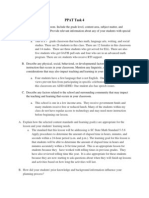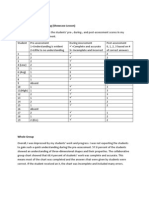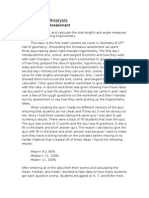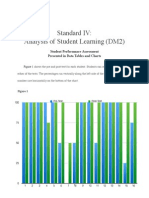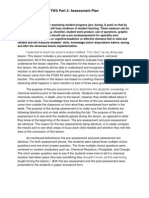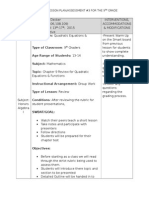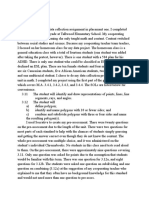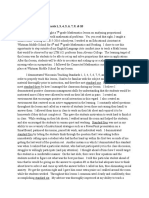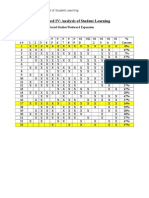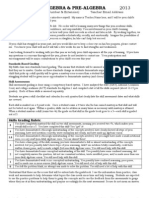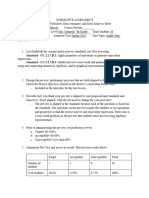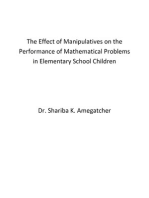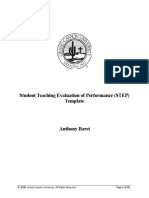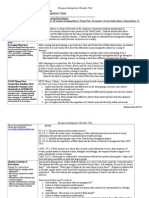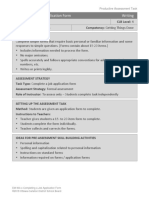Ec 329 Tws 6 Revised Morgan Chambers
Ec 329 Tws 6 Revised Morgan Chambers
Uploaded by
api-235237205Copyright:
Available Formats
Ec 329 Tws 6 Revised Morgan Chambers
Ec 329 Tws 6 Revised Morgan Chambers
Uploaded by
api-235237205Original Title
Copyright
Available Formats
Share this document
Did you find this document useful?
Is this content inappropriate?
Copyright:
Available Formats
Ec 329 Tws 6 Revised Morgan Chambers
Ec 329 Tws 6 Revised Morgan Chambers
Uploaded by
api-235237205Copyright:
Available Formats
Morgan Chambers EC 329 TWS 6 Analysis of Student Learning Data on Whole Class The table below shows the
data I collected before, during, and after my Showcase Lesson. My objective for this lesson was, Students will be able to write and tell time using both digital and analog clocks with at least 80% accuracy. Students 1 High 2 Middle 3 Low 4 5 6 7 8 9 10 11 12 13 14 15 16 17 18 19 20 21 Key Pre X student participated with correct answers During X student participated with correct answers Post X student participated with correct answers Pre X X XX X X X X X X X X XX X X X X XXXX X XX X X X X X X X X X-X X X XX XX-X During X X X X X X X X X X X X X X X X X X X X X Post
- student showed incorrect answer, but was able to fix it and show correct answer
- student needed help during worksheet, but afterwards were able to correctly finish by themselves -- student needed help during the worksheet and answered one or more incorrectly afterwards
To summarize, my data showed that the students had an understanding of the material and were able to successfully work through the standard and lesson objective. They were able to use the knowledge gained in the pre and during assessments to help them successfully complete their post assessment. Overall, all students were able to complete the lesson with at least 80% accuracy. The students who struggled with some questions during the pre and during assessments, were then able to correctly complete the post assessment, therefore they were able to fully complete the objective.
Results on Three Individual Students When I examined the data for my low-achieving student, the pre-assessment showed that the student has a basic understanding for showing time. There were a few times where the student had the answer incorrect, but they were minor things such as having the minute and hour hands switched around, or being off on the minute hand by five minutes. During the lesson, the student needed some help with some of the questions, but after working one on one with him, he was able to complete the worksheet with 100% accuracy. The post-assessment showed the student had a clear understanding of the assessment and was able to correctly complete it. This student had a good attitude and desire to learn throughout the lesson, even when he had to correct his answers he still had a desire to understand and worked until he got the correct answer. When I examined the data for my middle-level student, the pre-assessment showed that the student and a clear understanding for showing time. He was able to correctly show every answer to each question I asked. During the lesson, the student was able to correctly answer every question on the worksheet without any help. The post-assessment showed that the student had a
clear understanding of the assignment and was able to complete it correctly. This student had an eagerness to answer every question when asked and kept on task throughout the lesson. When I examined the data for my high-achieving student, the pre-assessment showed the student had a clear understanding of how to tell time and was able to successful show each answer when I asked. During the lesson, the student completed their worksheet without 100% accuracy without any help. He even helped his neighbors when they had questions on the worksheet and I was busy helping another student. The post-assessment showed that the student had a clear understanding of the assignment and was able to complete the assessment correctly. This student had a clear desire to learn and was fully engaged throughout the lesson. It is important to understand the learning of these particular students because they show the range of learning abilities in the classroom. By understanding how these types of students work, I will have a better understanding of how to approach and assess future lessons. Attached, you will find examples of these three students during assessments. The pre and post assessments were done through an observational checklist and that data is showed in the chart on the first page.
Key side 1
Key side 2
Student 1
Student 1
Student 2
Student 2
Student 3
Student 3
You might also like
- LRP 6 q1 285 Pages in All LRP 6Document54 pagesLRP 6 q1 285 Pages in All LRP 6Dixon Labado50% (2)
- Ppat Task 4Document7 pagesPpat Task 4api-122157048100% (1)
- Analysis ProjectDocument25 pagesAnalysis Projectapi-247153401No ratings yet
- Tws 6 Analysis of Student LearningDocument6 pagesTws 6 Analysis of Student Learningapi-235236994No ratings yet
- Tws 6 429Document10 pagesTws 6 429api-246132572No ratings yet
- Impact On Student Learning Taylor HunterDocument13 pagesImpact On Student Learning Taylor Hunterapi-437505410No ratings yet
- Tws 6 FinalDocument14 pagesTws 6 Finalapi-236766479No ratings yet
- Test ItemsDocument11 pagesTest ItemstoniasleeNo ratings yet
- Tws 6Document6 pagesTws 6api-185932738No ratings yet
- Part 2 3Document3 pagesPart 2 3api-662640100No ratings yet
- Evidence of Student LearningDocument43 pagesEvidence of Student Learningapi-294486031No ratings yet
- Analysis of Student LearningDocument3 pagesAnalysis of Student Learningapi-176741846No ratings yet
- Mary Catherine Tws 6 Analysis of Student Learning Final DraftDocument2 pagesMary Catherine Tws 6 Analysis of Student Learning Final Draftapi-176703960No ratings yet
- Reflection, Self-Evaluation, & Professional Development: A. Whole ClassDocument7 pagesReflection, Self-Evaluation, & Professional Development: A. Whole ClassTracie CoyneNo ratings yet
- Student AnalysisDocument3 pagesStudent Analysisapi-270413105No ratings yet
- Assessment Analysis FormativeDocument3 pagesAssessment Analysis Formativeapi-283617543No ratings yet
- Tws 8 Reflection Mary CatherineDocument3 pagesTws 8 Reflection Mary Catherineapi-176703960No ratings yet
- Project Report - Floyd Moretti 1Document13 pagesProject Report - Floyd Moretti 1api-708905787No ratings yet
- Tws 7 Instructional Decision MakingDocument4 pagesTws 7 Instructional Decision Makingapi-177752973No ratings yet
- Graph 1 PrepstcompairsonDocument4 pagesGraph 1 Prepstcompairsonapi-282314189No ratings yet
- Shaffer Tws Section 56Document7 pagesShaffer Tws Section 56api-237155227No ratings yet
- Tws 6 429finishedrevised-Channa GrihamDocument13 pagesTws 6 429finishedrevised-Channa Grihamapi-175333098No ratings yet
- Effective Writing-Report SmktelokkerangDocument6 pagesEffective Writing-Report SmktelokkerangSyafiqah MazlanNo ratings yet
- Stepp Review Activity 1Document6 pagesStepp Review Activity 1api-281839323No ratings yet
- Task 2 FinalDocument6 pagesTask 2 Finalapi-176697632No ratings yet
- DataanalysisDocument7 pagesDataanalysisapi-282019703No ratings yet
- Unit Pre PostforwebsiteDocument11 pagesUnit Pre Postforwebsiteapi-281994074No ratings yet
- Reflection SummaryDocument8 pagesReflection Summaryapi-660565967No ratings yet
- Impact On Students Learning ReflectionDocument4 pagesImpact On Students Learning Reflectionapi-308414337No ratings yet
- AnalysisDocument10 pagesAnalysisapi-283626583No ratings yet
- Tws 3 CompleteDocument4 pagesTws 3 Completeapi-213553729No ratings yet
- Data Analysis FinishedDocument10 pagesData Analysis Finishedapi-250697495No ratings yet
- Evidence of Student Learning Bethann Ilgenfritz Spring 2017Document16 pagesEvidence of Student Learning Bethann Ilgenfritz Spring 2017api-384755926No ratings yet
- Conjunction AdjuntsDocument13 pagesConjunction AdjuntsRothinam NirmalaNo ratings yet
- AnalysisDocument14 pagesAnalysisapi-247153401No ratings yet
- Analysis of Student Learning TwsDocument15 pagesAnalysis of Student Learning Twsapi-213181550No ratings yet
- Post-Test AnalysisDocument3 pagesPost-Test Analysisapi-426708730No ratings yet
- Check My Homework AnswersDocument8 pagesCheck My Homework Answersdwfuamapd100% (1)
- JHutcheson KAStep2Document3 pagesJHutcheson KAStep2Anonymous BMLoy33lNo ratings yet
- Ms. Chelsea Decker Lesson Plan/Assessment #3 For The 9: GradeDocument7 pagesMs. Chelsea Decker Lesson Plan/Assessment #3 For The 9: Gradeapi-285000116No ratings yet
- Sample2nd Yr PGE BDocument7 pagesSample2nd Yr PGE BJulian A.No ratings yet
- Data Analysis ScruggsDocument9 pagesData Analysis Scruggsapi-282053052No ratings yet
- Lesson Plan:: Write and Interpret Numerical ExpressionsDocument5 pagesLesson Plan:: Write and Interpret Numerical Expressionsapi-285000116No ratings yet
- Ued 496 Houseworth Cora Assignment 1 Data Project E-PortfolioDocument17 pagesUed 496 Houseworth Cora Assignment 1 Data Project E-Portfolioapi-649067130No ratings yet
- Task 2 FinalDocument5 pagesTask 2 Finalapi-122378129100% (1)
- Student Academic Progress Assessment Goal Statement: by The End of My Six Day Long Unit All of My Students Will Score at Least A 75%Document7 pagesStudent Academic Progress Assessment Goal Statement: by The End of My Six Day Long Unit All of My Students Will Score at Least A 75%api-282741728No ratings yet
- LP 4 RationaleDocument3 pagesLP 4 Rationaleapi-324016785No ratings yet
- Tws 8 FinalDocument3 pagesTws 8 Finalapi-235236994No ratings yet
- Task Analysis SequenceDocument5 pagesTask Analysis Sequenceapi-285961875No ratings yet
- Standard IV: Analysis of Student LearningDocument14 pagesStandard IV: Analysis of Student Learningapi-241349683No ratings yet
- ALGPRECurrNightSyllabus12 13Document3 pagesALGPRECurrNightSyllabus12 13algebrainiacNo ratings yet
- Unit Plan Summative Assessment AnalysisDocument7 pagesUnit Plan Summative Assessment AnalysisAnonymous Z9zcD6BzNo ratings yet
- Summative Assessment Unit Summary Sheet2Document4 pagesSummative Assessment Unit Summary Sheet2api-415881667No ratings yet
- Mooney Summative Assessment AnalysisDocument7 pagesMooney Summative Assessment Analysisapi-726949835No ratings yet
- Teacher Work SampleDocument8 pagesTeacher Work Sampleapi-237655094No ratings yet
- Standard 6-2Document6 pagesStandard 6-2api-737132759No ratings yet
- Tws 6Document4 pagesTws 6api-242288854No ratings yet
- Tws 1st DraftDocument60 pagesTws 1st Draftapi-241107610No ratings yet
- SummativeassessDocument4 pagesSummativeassessapi-430600147No ratings yet
- Edu 461 Trull Tws 6Document8 pagesEdu 461 Trull Tws 6api-177258160No ratings yet
- The Effect of Manipulatives on the Performance of Mathematical Problems in Elementary School ChildrenFrom EverandThe Effect of Manipulatives on the Performance of Mathematical Problems in Elementary School ChildrenNo ratings yet
- Ec 461 Tws 4 Morgan ChambersDocument11 pagesEc 461 Tws 4 Morgan Chambersapi-235237205No ratings yet
- Ec 461 Lesson Plan 1 Morgan ChambersDocument2 pagesEc 461 Lesson Plan 1 Morgan Chambersapi-235237205No ratings yet
- Ec 329 Tws 4 Revised Morgan ChambersDocument3 pagesEc 329 Tws 4 Revised Morgan Chambersapi-235237205No ratings yet
- Ec 329 Lesson Plan 5 Morgan ChambersDocument3 pagesEc 329 Lesson Plan 5 Morgan Chambersapi-235237205No ratings yet
- Math Lesson Plan: Model To Show The Quotient. Use The Relationship Between Multiplication and DivisionDocument4 pagesMath Lesson Plan: Model To Show The Quotient. Use The Relationship Between Multiplication and Divisionapi-455835172No ratings yet
- Paradox, Irony and Paradox (Evaluative Demo)Document4 pagesParadox, Irony and Paradox (Evaluative Demo)DezmeinNo ratings yet
- Lesson 5 Sociocultural and Life ApplicationDocument4 pagesLesson 5 Sociocultural and Life Applicationapi-355668273No ratings yet
- IlpDocument7 pagesIlpapi-483530581No ratings yet
- IlprosalesDocument5 pagesIlprosalesapi-679130868No ratings yet
- English Poetry UnitDocument5 pagesEnglish Poetry Unitapi-372226231No ratings yet
- 9montalbo VillanuevaDocument21 pages9montalbo VillanuevaCHRISTINE BRONNo ratings yet
- Lesson Plan Design: Ccss - Ela-Literacy - Rf.2.3Document6 pagesLesson Plan Design: Ccss - Ela-Literacy - Rf.2.3api-323520361No ratings yet
- Formative Assessment StrategiesDocument20 pagesFormative Assessment StrategiesGraceEstoleCaloNo ratings yet
- Lesson Plan - 1Document5 pagesLesson Plan - 1api-286837832No ratings yet
- Creating Our Own Stories! Allie Mcadow: Common Core StandardsDocument5 pagesCreating Our Own Stories! Allie Mcadow: Common Core StandardsAllieNo ratings yet
- Week 13 English 7Document5 pagesWeek 13 English 7Jerline Jane AntioquiaNo ratings yet
- Step TemplateDocument20 pagesStep Templateapi-524006161No ratings yet
- 3rd Grade Story Quilt Lesson Plan 1Document5 pages3rd Grade Story Quilt Lesson Plan 1api-445729585No ratings yet
- Enrichment and AccelerationDocument65 pagesEnrichment and AccelerationJomar Carabot100% (2)
- Household - G9 TG Final As of February 10Document22 pagesHousehold - G9 TG Final As of February 10Alejandro Timbad Jr.67% (3)
- Philosophy Quarter 1 Module 7Document27 pagesPhilosophy Quarter 1 Module 7Camille TagaloyNo ratings yet
- Science Lesson Plan Grade 2Document10 pagesScience Lesson Plan Grade 2api-272896513No ratings yet
- Task 1Document3 pagesTask 1api-399175357No ratings yet
- Sse 6115 Lesson Plan 1 Diary EntriesDocument7 pagesSse 6115 Lesson Plan 1 Diary Entriesapi-288702670No ratings yet
- Montgomery Mandala Lesson PlanDocument12 pagesMontgomery Mandala Lesson Planapi-356610604No ratings yet
- Final Short Story and Culture Sept 2010Document97 pagesFinal Short Story and Culture Sept 2010Kyth SomozoNo ratings yet
- Lesson Plans Weebly 329Document10 pagesLesson Plans Weebly 329api-200994898No ratings yet
- Concept AttainmentDocument8 pagesConcept AttainmentM'Grace Sagrado Tagailo LptNo ratings yet
- Dew - Game Based QuizizzDocument10 pagesDew - Game Based Quizizzapi-634068749No ratings yet
- Reduce, Reuse, Recycle Lesson PlanDocument7 pagesReduce, Reuse, Recycle Lesson PlanKristan OnofrioNo ratings yet
- Module 8 Critical Thinking Reflection Otl 502Document7 pagesModule 8 Critical Thinking Reflection Otl 502api-324732767No ratings yet
- EM - W4 - C - Completing A Job Application FormDocument3 pagesEM - W4 - C - Completing A Job Application FormDanniNo ratings yet
- Math10 TG U2Document132 pagesMath10 TG U2June Emerson ManalangNo ratings yet

